Discover the Unique Stories Behind America’s State Trees and Flowers Part 3: The Midwest
Photo by Hans Isaacson on Unsplash
Introduction
People often call the Midwest “America’s heartland.” This region has a mix of different landscapes , from open prairies to thick forests. Each state in the Midwest has chosen state flowers and trees that represent its nature, history, and culture. These plants often have interesting stories behind why they were chosen and play important roles within each of their states. Follow along with us as we learn about what makes these plants special, why they matter, and some surprising ways people use them. From the white oak of Illinois to the wild prairie rose of North Dakota, these state plants tell us a lot about what makes the Midwest unique.
ILLINOIS
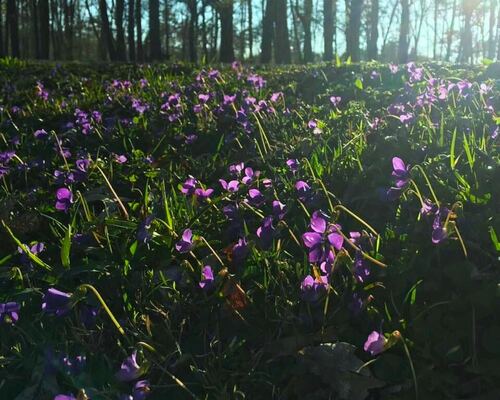
A Field of Common Blue Violets – Photo by Debra Manny Mosley on Unsplash
The white oak, chosen as Illinois’ state tree in 1973, is a majestic and long-lived species of tree. It has been an important part of the state’s culture and natural landscape. This gentle giant stands up to one hundred feet tall and can outlive generations of families. With bark as gray as a Chicago winter sky and leaves that paint the fall landscape in fiery reds and browns, the white oak is a year-round showstopper. This species played an important role in Illinois’ history. It provided wood for creating buildings, ships, and furniture when the state was first developing. These trees are also home to many small creatures and keep the soil from eroding with their deep root systems. As the state tree, the white oak stands as a symbol of the Prairie State’s strength, endurance, and deep connection to the land.
While the white oak represents Illinois’ towering strength, a more delicate plant captures the state’s gentle beauty at ground level. Since 1908, Illinois has honored the common blue violet as its state flower. This humble yet charming flower is native to the state and can be found blooming all over, from woodlands to prairies and even in cities. Violets usually bloom in the early spring, with delicate five-petaled flowers in shades of purple, white, and yellow. Even though it may be small, the violet has been very important to Illinois’ nature and culture. Chosen by the schoolchildren of the state, this flower is loved for its beauty. It is also valued for its strength, since it can thrive in many different environments. Some species of violets can also be used in folk medicine and as edible flowers. For most of the people of Illinois, though, the violet is a sign that winter is coming to an end—warmer days are on the way!
INDIANA
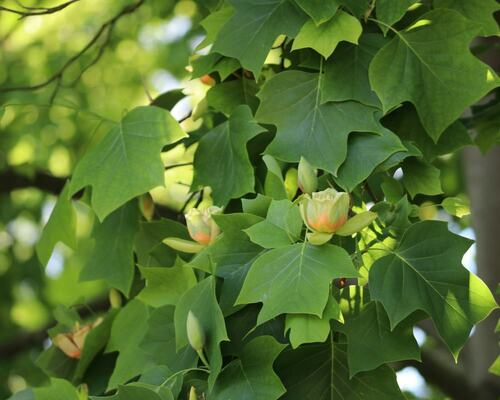
The Tulip Tree’s Signature Leaves & Flowers – Photo by Romain Verdy-Ricard on Unsplash
Standing tall since 1931 as Indiana’s leafy ambassador, the tulip tree is a true Hoosier giant with a story as colorful as its blossoms. Also known as yellow poplar or tulip poplar, it’s one of the biggest native trees in eastern North America. It can grow to impressive heights of up to 150 feet, with a straight, columnar trunk and a broad, spreading crown. The tree gets its name from its distinctive flowers, which resemble tulips with greenish-yellow petals and a splash of orange at the base. These tulip-like flowers bloom in the spring, while the tree’s large, uniquely shaped leaves turn a brilliant golden yellow in the fall. But this tree isn’t just pretty—its wood has been valued for its strength and resistance to splitting since pioneer times. Even today, it’s still used for timber. It is also planted in parks and gardens across Indiana. Chosen for its deep roots in the state’s forested history and its ability to grow quickly , this tree stands as a metaphor for Indiana itself—strong, resilient, and always reaching for the sky. Whether you spot it in a park or forest, this tree is a reminder that, in Indiana, both nature and ambition grow tall.
From the towering heights of the Tulip Tree, we turn our attention to a flower that brings beauty and fragrance to Indiana’s gardens at ground level. The peony , which was adopted as Indiana’s state flower in 1957, is a beloved symbol of the state’s history of gardening. It’s known for its large flower and sweet scent and has been grown in Indiana for many years. Even though it isn’t from North America, peonies have thrived in the state since it was brought over. These flowers come in many different colors, like pink, red, white, and yellow. They also can come in single and double-flowered varieties. Peonies usually bloom in late spring to early summer, making a beautiful sight in gardens across the state. Indiana’s relationship with the peony goes beyond just looks; the state has a long history of growing peonies. Some nurseries have even specialized in these flowers for over one hundred years! The peony’s hardiness, longevity, and low maintenance have made it well loved among Indiana gardeners. As the state flower, the peony represents Indiana’s natural beauty and farming traditions as well as the enduring spirit of its people.
IOWA

A Pale-Pink Wild Rose – Photo by Paula Czyżak on Unsplash
The bur oak is Iowa’s state tree. This impressive oak is well known for its strength and long life, being able to endure fire, dry weather, and cold temperatures better than any other oak tree. This makes the bur oak well suited to growing in Iowa’s changing climate. But what really sets this tree apart is its ability to grow faster and live longer than any other kind of oak. These qualities make the bur oak a good symbol of Iowa’s strength and endurance.
While the bur oak stands as a testament to Iowa’s endurance, another plant embodies the state’s more delicate beauty. The wild rose has been Iowa’s state flower since 1897. This sturdy native plant is a fitting symbol of the state’s beauty and the strength of Iowa’s natural landscape. Its delicate five-petaled flowers usually bloom from June to late summer in many shades of pink. These sweet-smelling flowers, usually about two inches wide, stand out against the plant’s dark-green leaves. The wild rose grows all over Iowa, from its prairies to its woodlands and even on the roadsides. This shows just how well adapted it is to the state’s environment. This plant also plays an important role in local ecosystems, providing food and homes for many animals. Iowa picked this flower as its state symbol because it embodies the essence of the state—modest, resilient, and quietly beautiful. From official emblems to backyard gardens, the wild rose continues to capture the heart of Iowa, proving that sometimes, the best things in life really are homegrown.
Kansas
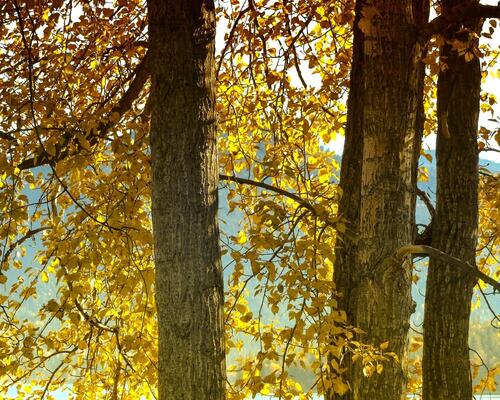
Eastern Cottonwood Trees in Autumn – Image by Brigitte Werner from Pixabay
The eastern cottonwood, Kansas’ state tree, is a majestic and fast growing tree. It grows along rivers and moist lowlands. This giant can reach heights of one hundred feet and is known for its rustling, triangular leaves that add a touch of music to the landscape. But the cottonwood can do more than just provide shade and beauty; it also has surprising nutritional uses. The bark of this tree is commonly used as food for horses, giving them essential nutrients. People can eat parts of the tree, too; its sweet sprouts can be eaten raw or cooked. Its vitamin-rich inner bark can also be used in teas or as a survival food. This versatility makes the eastern cottonwood a perfect symbol for Kansas—a tree that’s not only visually striking but also unexpectedly useful, embodying the practical and strong spirit of the state.
While the eastern cottonwood reaches skyward along Kansas’ waterways, another plant turns its face to the sun across the state’s vast fields. The sunflower is Kansas’ state flower and is a symbol of natural beauty and of its importance in farming. These notable plants, with their bright-yellow petals, can grow impressively tall. Some varieties can even reach up to sixteen feet! Sunflowers are well known for their impressive ability to track the sun’s movement across the sky. This is known as heliotropism . This interesting behavior can be seen most often in young sunflower plants—the buds of these young plants actively rotate from east to west throughout the day, following the sun’s path. At night, they gradually turn back to the east, ready to greet the morning sun. This daily rotation helps the plants absorb as much sun as they can. This helps them reach their impressive heights. As sunflowers get older and their heads become heavier, they usually settle facing toward the east. Beyond their beauty, sunflowers are also valued for their seeds and oil. This dual nature as both an iconic symbol and a useful crop perfectly embodies Kansas’ deep connection to its land and natural heritage.
MICHIGAN

A Cluster of Apple Blossoms – Image by Esiul from Pixabay
The eastern white pine has been Michigan’s state tree since 1955. These massive trees can grow as tall as eighty to one hundred feet, with certain trees even reaching up to 150 feet! These conifers can be easily spotted by their groups of five long needles and cones. Once dominating the forests of the Great Lakes region, the eastern white pine played an important role in Michigan’s development. This was especially true during the 19th-century logging boom. Its straight, strong timber was prized for building ships, furniture, and other construction projects across the state. Even though it may not be as common as it was before due to extensive logging, this species of pine is still important to the wildlife in the area. It provides shelter and food for many of the forest creatures that live nearby. Today the eastern white pine stands as a living symbol of Michigan’s complex relationship with its natural resources. It represents the state’s logging history and commitment to protecting the forest. Its continued presence in Michigan’s forests serves as a reminder of the delicate balance between economic development and environmental stewardship.
From the towering eastern white pine that once dominated Michigan’s forests, we turn to a more delicate but equally significant symbol of the state’s natural bounty. The apple blossom has been Michigan’s state flower since 1897. It elegantly symbolizes the state’s history of farming as well as its natural beauty. These delicate flowers have five petals each and range from pale-pink to white, with some darker pink streaks extending from the center of the flower. They decorate apple trees each spring, creating a beautiful sight while emitting a subtle, sweet scent. The apple blossom’s selection as the state flower emphasizes the fact that Michigan is one of the biggest producers of apples in the country. The apple blossom also shows the important role that pollinators (like bees) have in nature. This is especially true when it comes to the fruit industry. While the flower represents the promise of a good harvest , it also reminds us of the challenges farming faces today, like climate change and the decline of pollinators. Thus, the apple blossom stands as a complex symbol; a symbol of Michigan’s natural beauty, its skill in farming, and the ongoing need to preserve the environment around us.
MINNESOTA

Red Pine Branches Lined with Pine Cones – Image by Manseok Kim from Pixabay
The red pine has been Minnesota’s state tree since 1953. This conifer symbolizes both the state’s natural beauty and its tricky relationship with the forest. It’s known for its tall, straight trunk, which can reach from sixty to one hundred feet, as well as its reddish-brown bark and dark-green needles. This tree plays an important role in the ecosystem, providing food and shelter for wildlife nearby. It also has been prized as a source of timber for construction and for pulpwood. The red pine is native to North America and is well adapted to Minnesota’s climate and sandy soil. It represents the state’s vast forests and its logging history. However, its prominence also showcases ongoing challenges in managing the forest, like the balance between logging and conservation. The red pine’s strength in harsh northern conditions symbolizes the hardy spirit of Minnesotans. As Minnesota’s state tree, the red pine serves as a living reminder of the state’s natural resources and the importance of balancing the health of the forest with economic benefits.
While the red Pine reaches skyward in Minnesota’s forests, a more elusive treasure blooms closer to the ground, captivating nature enthusiasts with its rarity and beauty. The pink-and-white lady’s slipper has been Minnesota’s state flower since 1902. It can also be called the “showy lady’s slipper.” This stunning orchid has a special strategy to reproduce; it grows about half a million seeds per year! Every seed is so small that it looks like flower dust. This strategy helps the orchid to overcome the tough conditions of the wild. Even with so many seeds, these flowers are rare in Minnesota because of how hard they are to grow. One of the most amazing things about this flower is how long it can live—some of them are over one hundred years old! This is an amazing feat for such a delicate flower. The beauty and rarity of the pink-and-white lady’s slipper makes it a symbol of Minnesota’s unique history and shows how important protecting nature is.
Missouri

Hawthorn Flowers on a Branch – Image by Dominik Rheinheimer from Pixabay
The flowering dogwood has been Missouri’s state tree since 1955. This small, deciduous species shows off the state’s natural beauty and variety. It’s native to North America and usually grows between twenty and forty feet tall. This tree is famous for its spring flowers, which are actually groups of small yellow flowers surrounded by four large pink or white bracts that act as petals. The flowering dogwood also plays an important part in nature, providing shelter and food for the wildlife in the area. However, its popularity as a decorative tree has led to it being overharvested in some areas. These trees also face challenges from diseases like dogwood anthracnose. As Missouri’s state tree, the flowering dogwood represents both the state’s natural history and the need to protect certain native species of trees. Its presence in the state is a reminder of the delicate balance between appreciating nature and keeping the environment healthy.
While the flowering dogwood represents Missouri’s history of trees, another plant holds equal significance in the state’s natural identity. The hawthorn blossom has been Missouri’s state flower since 1923. It’s estimated to have over seventy-five different native species in Missouri! These small trees or shrubs are part of the rose family and usually bloom in the spring with groups of sweet-smelling five-petaled flowers. They usually appear white but can also be pink or red sometimes. While they may be pretty and beneficial to pollinators in the area, hawthorns are also important to the environment. Their thorny branches provide shelter for wildlife, and their “haws,” which ripen in the fall, serve as an important source of food. However, with so many kinds of hawthorns, it can be hard to identify them—some species may even be considered invasive in some contexts. As Missouri’s state flower, the hawthorn flower symbolizes the state’s beauty and its complex relationship with the environment. It reminds us of the importance of protecting the diversity of native plants while also managing the impacts they may have.
NEBRASKA

Flowering Goldenrod Stems – Image by Manfred Richter from Pixabay
The cottonwood , Nebraska’s state tree since 1972, is not only a prominent feature of the state’s landscape but also a tree with significant medicinal value. Native Americans and early settlers recognized the cottonwood’s healing properties, utilizing various parts of the tree to treat a wide range of ailments. The tree’s bark, leaves, and buds contain compounds that have been traditionally used to address diverse health issues, including rheumatism, fevers, tuberculosis, intestinal worms, menstrual cramps, and whooping cough. This medicinal versatility underscores the cottonwood’s importance beyond its role in the ecosystem. The tree is also known for its rapid growth and ability to thrive in Nebraska’s challenging climate, making it a symbol of resilience and adaptability. Cottonwoods play a crucial role in riparian ecosystems, stabilizing riverbanks and providing habitats for wildlife. Their distinctive seeds, carried on cottony tufts that give the tree its name, create a memorable “snow” effect in early summer, adding to the tree’s charm and cultural significance in Nebraska.
While the cottonwood stands tall as Nebraska’s arboreal symbol, another plant, equally rooted in the state’s history and ecology, adds a golden touch to its natural landscape. The goldenrod, Nebraska’s state flower since 1895, is a bright and misunderstood plant that colors the state’s prairies and roadsides with its brilliant yellow blooms. Despite its widespread presence and beauty, goldenrod has long been unfairly blamed for causing seasonal allergies. However, this is a common misconception. While some claim goldenrod causes allergies, its pollen is too heavy to be carried by the wind, making it unlikely to cause hay fever symptoms. In fact, goldenrod relies on insects for pollination, not wind dispersal. The real allergy offender is often ragweed, which blooms at the same time and has lightweight, wind-borne pollen. Goldenrod’s importance extends beyond its aesthetic appeal; it plays a crucial role in Nebraska’s ecosystems, providing late-season nectar for pollinators like bees and butterflies. Native Americans and early settlers also recognized the plant’s medicinal properties, using it to treat various ailments. Today, goldenrod continues to symbolize Nebraska’s natural beauty and resilience, thriving in diverse habitats across the state and serving as an important part of its prairie heritage.
North Dakota

A Leafy Branch of American Elm – Image by Hans from Pixabay
The American elm was chosen as North Dakota’s state tree in 1937. It is very well suited to the state’s changing weather. These impressive trees can grow up to 120 feet tall and are known for their durability. American elms can withstand the severe cold of North Dakota’s winters. They’re strong enough to handle temperatures as low as -45°F! These impressive trees also bring beauty to the state, with their spring flowers bursting into bloom from March to May. This combination of strength and beauty reflects the diverse qualities of North Dakota itself—a place of natural challenges and beauty. The American elm serves as a good representation of the state’s strong character.
While the American elm stands as a towering symbol of North Dakota’s resilience, a more delicate yet equally hardy plant paints the state’s prairies with its bright colors. The wild prairie rose became North Dakota’s state flower in 1907. This pink flower brightens roadsides and pastures across the state, adding a touch of color to the rolling prairies. It’s more than just pretty, though—it’s tough enough to thrive in North Dakota’s challenging weather. The rose also has a special place in the state’s educational history. In 1889, the University of North Dakota’s first graduating class chose pink and green as their school colors. This choice was inspired by the “green prairies and rosy prospects” symbolized by the flower. This choice linked the wild prairie rose to both the state’s landscape and its academic ambition. By becoming the state flower later, it came to represent North Dakota’s natural beauty and forward-looking spirit.
OHIO
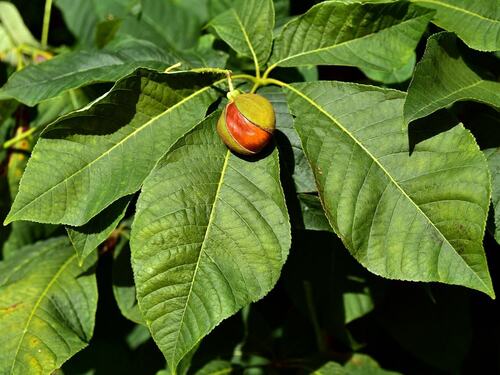
Leaves & Fruit of the Ohio Buckeye – Image by Leopictures from Pixabay
The Ohio buckeye, Ohio’s official state tree, is a distinctive and historically significant species native to the Midwest. It’s known for its unique fruit, which gives the tree its common name. In the fall, a spiny green husk splits open to reveal a smooth, round nut. This nut’s appearance is what gives the tree its name—its rich brown color with a light tan circle looks just like a deer’s eye, or “buck’s eye.” This resemblance was first noticed by Native Americans and early settlers. The buckeye has become so important to Ohio that people from the state often call themselves “Buckeyes.” Beyond its looks, the tree has played a role in local folklore, traditional medicine, and early American woodworking. It’s a tree that’s truly woven into Ohio’s history and culture.
While the Ohio buckeye tree embodies the state’s history and culture, another symbol, rooted in political history, adds a vibrant splash of color to the state. Ohio’s state flower, the scarlet carnation, has a touching story behind it. This bright-red flower became the state’s official bloom in 1904, but its importance goes back even further. The flower gained prominence due to its association with President William McKinley, a native son of Ohio who was tragically assassinated in 1901. McKinley was known for his habit of wearing a scarlet carnation in his lapel, considering it a good luck charm. Legend has it that moments before his assassination, he gifted his carnation to a young fan. Because of this connection, Ohio chose the scarlet carnation as its state flower to honor McKinley’s memory. The scarlet carnation thus represents not only the natural beauty of Ohio but also stands as a symbol of the state’s political legacy and the enduring impact of one of its most prominent historical figures.
SOUTH DAKOTA
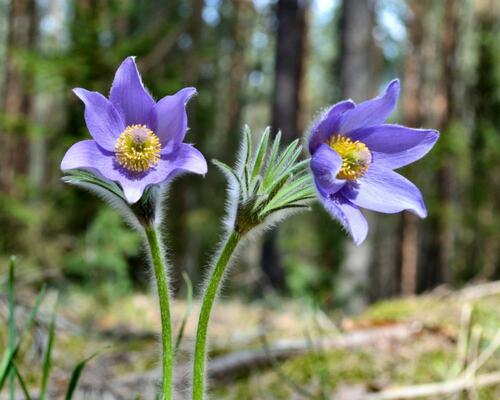
Pasque Flowers in a Field – Photo by Evgen Slavin on Unsplash
The Black Hills spruce, South Dakota’s state tree, is a unique and strong conifer native to the region. This tree is a natural variety of the white spruce, adapted to the Black Hills area. It’s considered a “distinct geographical variety.” Its compact size and slower growth rate are what separate it from its eastern cousin, the white spruce. Usually reaching heights of thirty to sixty feet, the Black Hills spruce can live for over 150 years. It symbolizes the lasting nature of South Dakota’s environment. This tree isn’t just important to the environment. Native Americans ate the inner bark and shoots and used the sap as natural chewing gum. This shows how the tree has been important as both a natural resource and as part of local traditions. By choosing it as the state tree, South Dakota recognized both its unique fit for the local environment and its long history with the area’s people.
South Dakota’s state flower, the pasque flower, embodies the state’s spirit as much as the Black Hills spruce. Adopted in 1903, this small purple wildflower often blooms first in spring, even through the snow, earning names like “May Day flower.” Settlers saw it as winter’s end, and South Dakotans still eagerly await its arrival. Its lavender petals and golden center brighten barren landscapes. Despite being toxic if eaten, Native Americans and settlers used it carefully as medicine, especially for eye problems. Some still study its medical uses, but only experts should handle it. The pasque flower’s toughness, early blooming, and complex human relationship make it a perfect symbol of South Dakota’s beauty and resilience.
WISCONSIN
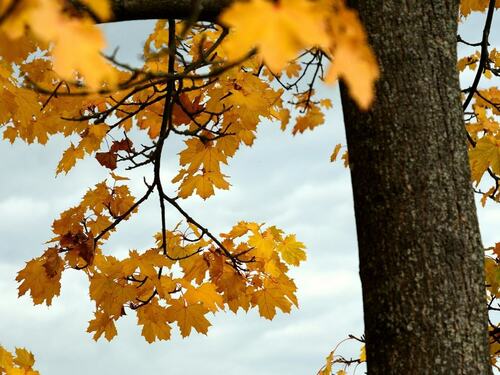
A Sugar Maple in Autumn – Image by congerdesign from Pixabay
The sugar maple was chosen as Wisconsin’s state tree by schoolchildren in 1893. It’s native to northeastern North America and is so well loved that several other states have also chosen it as their official state tree. It is considered one of the most important hardwoods in the world! The sugar maple is prized for its dense, tough wood and its sweet sap used for making maple syrup. But this tree isn’t just important to people—it’s also important for wildlife. The high sugar levels throughout the tree attract many kinds of animals, like squirrels, rabbits, and deer. These animals feed on its seeds, leaves, and buds. This shows how important it is to the ecosystem by helping to support many kinds of animals and maintain balance. Its choice as Wisconsin’s state tree shows both its usefulness and its role in nature.
While the sugar maple stands tall as the state tree of Wisconsin, a humbler yet equally beloved plant carpets the state. The wood violet was chosen to be Wisconsin’s state flower by school children in 1909, showing how loved it was by the children. It was then officially adopted as the state flower in 1949. Its small purple flowers can be found all over the state—in fields, forests, wet woodlands, meadows, and even along the road! Interestingly, the violet is also the state flower of Illinois, New Jersey, and Rhode Island. This shows just how popular it is across different regions! Besides its beauty, the wood violet is also edible. Its flowers and leaves are commonly used in salads, candies, and jellies, adding a touch of natural Wisconsin flavor to foods. This combination of beauty, abundance, and usefulness makes the wood violet a good representative of Wisconsin’s natural history and resourcefulness.
In Conclusion
The state trees and flowers of the Midwest are more than just symbols; they are examples of each state’s nature, history, and stories. Each of these plants play important roles in their habitats by supporting wildlife and reminding us of the region’s farming history and our need for conservation.
Do you have a personal story about your state’s official plant? We’d love to hear how these natural symbols have impacted your life or community. Sharing these stories helps us better appreciate the deep connection between people and nature in the Midwest. As we face environmental challenges, these state plants remind us to preserve our natural world for future generations.
Don’t miss the rest of this blog series!


